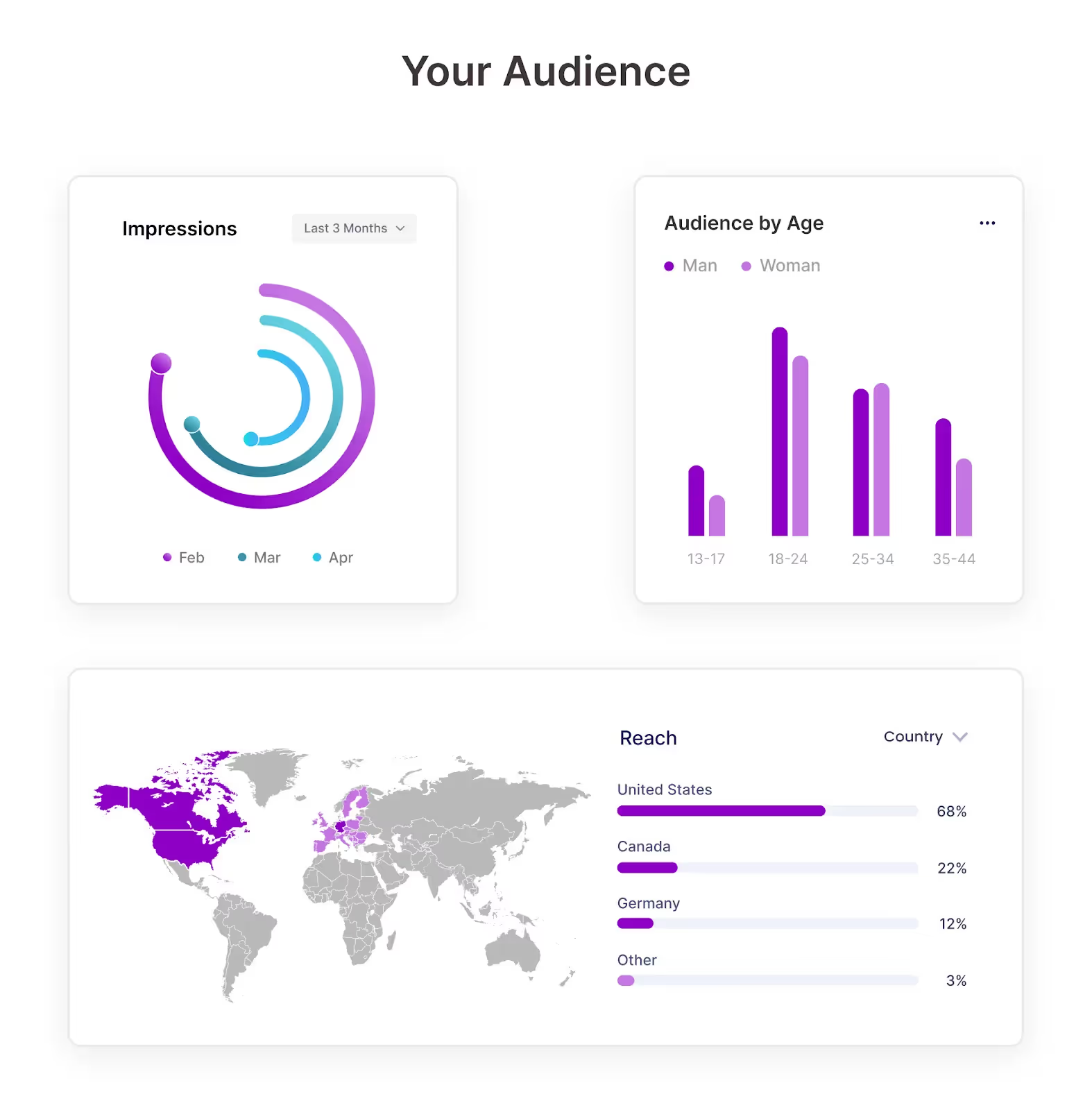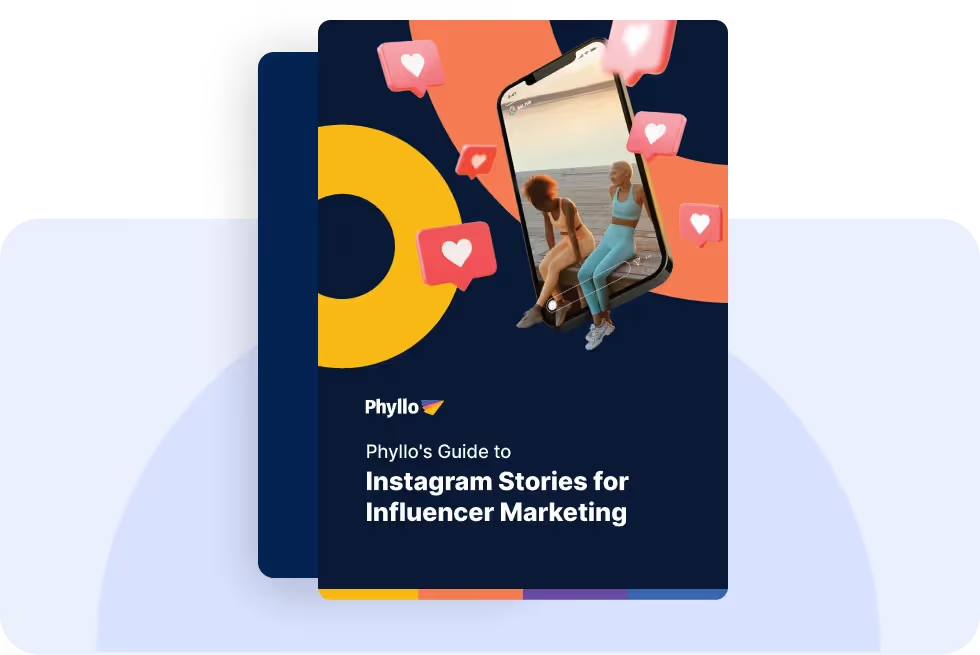Did you know that 80% of marketers find influencer marketing effective for reaching target audiences and achieving goals? Collaborating with influencers who align with your brand can greatly enhance awareness, credibility, sales, and revenue.

But how can you ensure an influencer will positively impact your brand? Influencer audience analysis is key.
Analyzing an influencer’s audience can help you uncover crucial demographic (age, gender) and psychographic (interests, behaviors) insights to determine whether your products or services can potentially appeal to them.

Additionally, this analysis can reveal the influencer’s relationship with their audience. For example, micro-influencers often have more engaged followers than macro-influencers. Understanding an influencer's audience helps you accurately estimate campaign ROI and choose partners who best drive your influencer marketing strategy.
This blog offers a comprehensive overview of influencer audience analysis, its importance, key metrics, data collection tools, and steps to conduct a successful analysis.
What is Influencer Audience Analysis?
Influencer audience analysis is the method of evaluating an influencer's following in terms of their demographics, such as age, gender, occupation, income, and location, as well as psychographics, such as interests, lifestyles, values, personalities, and behaviors.
The goal is to determine whether their followers will likely be interested in your products or services, interact with your content, and convert into paying customers for your business.

You can carry out an influencer audience analysis to —
- Identify influencers who have an interested and relevant follower base
- Ensure your influencer marketing initiatives are customized to the needs and interests of the influencer's fan base
- Assess the effectiveness of your influencer marketing collaborations by monitoring metrics, such as audience impact, engagement, and earned media value
Importance of Audience Analysis in Influencer Marketing
As mentioned above, conducting an influencer audience analysis helps anticipate the needs and wants of your target prospects.
Brands should adopt an audience-centered strategy to increase the efficacy of their communication activities and ensure that messages are appropriately developed and conveyed. However, pinpointing your target audience through in-depth research can be challenging. Thus, audience adaptability frequently depends on a good dose of creativity.
You must attempt to be accurate in your assumptions, though, which you can do using tools such as Phyllo's Audience API. The Audience API, which is an extension of Phyllo's Identity API, allows you to obtain the demographic data for a creator's lifetime audience.

Now that you know what influencer audience analysis is and why it can be important for your brand, let’s understand how you can perform one.
There are two main aspects to conducting an influencer audience analysis: evaluating key performance indicators (KPIs) and collecting data using the right tools and techniques.
Let’s understand both in detail below.
Key Metrics to Evaluate
Audience demographics and audience psychographics are, without a doubt, the most vital key metrics to evaluate in an influencer audience analysis. What do they include?
Audience Demographics
- Gender: Knowing the gender breakdown can help tailor campaigns more effectively.
- Age: Understanding the age distribution helps ensure the influencer’s followers match the target market.
- Location: Geographic data indicates where the followers are based, ensuring brand market relevance.
- Education Level: Understanding the educational background can provide insights into the audience's interests and needs.
- Income Level: Gauging the income levels helps predict the purchasing power and affordability of the brand’s products.

Audience Psychographics
- Interests: Identifying common hobbies and interests ensures the influencer’s content aligns with the brand’s niche.
- Lifestyle: Knowing the audience’s lifestyle choices can help in creating more relatable and engaging campaigns.
- Values and Beliefs: Ensuring the audience’s values align with the brand’s message enhances authenticity and engagement.
- Personality Traits: Recognizing traits like creativity or boldness helps tailor the brand’s message to resonate better.
- Buying Behavior: Understanding how the audience shops, including brand loyalty and sensitivity to promotions, can guide marketing strategies.
Tools and Techniques for Data Collection
While you can conduct research for an influencer audience analysis using manual methods, it can be complicated and time-consuming, especially when you have so many great tools and techniques available for data collection at your fingertips.
Let’s look at some popular types of tools you can use to analyze an influencer’s audience.
Tools for Influencer Audience Data Collection
- Social Media Analytics Tools: These are tools built into popular social media platforms today that can help marketers decipher audience demographics, influencer engagement rates, post reach, and traffic sources.
For example, Instagram Insights provides data on follower demographics, engagement, reach, impressions, and more for Instagram influencer accounts, and YouTube Analytics offers information on viewer demographics, watch time, and traffic sources.
- Third-Party Analytics Platforms: These are third-party platforms and APIs that integrate with modern-day social media networks to extract real-time information about an influencer’s audience.
For instance, the universal API from Phyllo extracts creators’ data from platforms such as Instagram, YouTube, Facebook, Twitter, Pinterest, and many more. This allows marketers to assess an influencer’s target audience, engagement rate, and more so that they can correctly estimate the ROI these creators can generate.
- Survey and Polling Tools: These include software such as Google Forms, which allows you to create surveys to collect audience information directly, and SurveyMonkey, which provides tools for creating detailed surveys and analyzing responses.
- Influencer Marketing Platforms: These are software like Aspire, Traackr, and Influencity that offer comprehensive influencer analysis reports on creator audiences, including demographics, follower authenticity, engagement, and relationship data.
Now, let's dive into the techniques you can use for influencer audience analysis.
Techniques for Influencer Audience Analysis
Audience data can be collected in the following ways —
- Direct Data Extraction: This can be done manually or using a social media platform API. You can also use a third-party API that directly integrates with the source platform, such as the one offered by Phyllo.
While manually gathering data from public posts and profiles typically involves using web scraping tools, a social media platform API, such as the Instagram API, YouTube API, etc., can enable marketers to gather real-time information directly from an influencer’s profile. In contrast, using a third-party API like Phyllo offers many more capabilities than traditional social media platform APIs (will be discussed later).
- Audience Surveys: Data about an influencer’s audience can also be collected using surveys or polls. These enable respondents (i.e., influencer audiences) to offer direct feedback about their demographics, interests, and behaviors.
- Content Analysis: This involves analyzing the type of content posted by the influencer and how the audience interacts with it. This can involve categorizing posts and tracking engagement metrics for different content types.
- Engagement Analysis: Analyzing the type of engagement an influencer’s post generates can also be a great indicator of how active their followers truly are.
You can calculate engagement rates by taking stock of the likes, comments, shares, and saves an influencer’s content receives to assess the quality of their audience interactions. This can involve statistical analysis of engagement metrics over time.
Conducting Influencer Audience Analysis (A Step-By-Step Guide)
Let's now examine the steps for carrying out an influencer audience analysis.
Remember that in order to guarantee the most precise understanding of the target audience, the approach needs to be thorough and data-driven.
Understand the Influencer’s Niche
Understanding the influencer's niche and content style is crucial before delving into the finer points of an influencer audience analysis.
You can grasp the interests of an influencer’s audience by recognizing the kinds of content the creator produces, the subjects he or she covers, and the tone in which the influencer communicates their message.
Pull a Sample of Followers and Verify The Authenticity of Their Accounts
It is impractical to check each follower manually when performing an influencer audience analysis. In contrast, you can consider pulling a sample of followers from a few recent posts of the creator you have chosen as an example.
This step helps comprehend the credibility of the influencers’ followers. If you observe that some of the influencer's followers and engagements come from phony or defunct accounts, it is likely that the influencer's "influence" is false.
Analyze the Audience Demographics of the Sample of Followers You Pulled Before
Once you are assured that the sample of audience you pulled before has real and verified accounts, you can now go ahead and identify the audience’s demographics, such as their age groups, gender distribution, geographical locations, and language preferences.
It is important to note how well these characteristics match your buyer personas. You can also try to understand the regional differences and the cultural nuances of your audience sample to determine what kind of messaging would resonate more with them. This can help you tailor your campaigns for influencer marketing success.

Identify the Audience’s Behavioral Patterns
In addition to demographic analysis, marketers must pay close attention to an audience's behavioral patterns to gain insights into their interests, habits, preferences, and online activities.
You must examine important performance metrics, including the most popular content categories with the audience, the most popular posts and hashtags, and the quantity of comments, likes, and shares each influencer has shared on each post. This can help you improve your overall influencer marketing strategy to generate more ROI for your brand.
Create an Influencer Audience Analysis Spreadsheet To Record Your Insights
You must compile as much data as you can into a spreadsheet. Assessing an influencer's audience takes work, but if you record your observations, you can make your task more effective when you review the rest of your list of potential customers. Your influencer audience analysis spreadsheet must contain the following categories:
- Name of a creator and their social media handle(s)
- Names of social channels
- Number of followers
- List of recent posts with links attached
- Size of audience sample(s)
- Gender ratio
- Age groups
- Language / Country / Ethnicity
- Common interests and values
- Most used brand hashtags
- Quality of comments / Post discussions
- Notable followers (followers who are also influencers)
- Engagement metrics (likes, comments, shares, and saves)
How Phyllo Facilitates Audience Analysis?
Phyllo is a leading influencer marketing platform with its own specialized universal API. This API supports the extraction of creator data from source platforms like Instagram, YouTube, Facebook, Twitter, LinkedIn, Pinterest, Twitch, and many more.

The data you can access through Phyllo’s API is real-time information about an influencer’s audience demographics, engagement metrics, and more.
While Phyllo’s universal API offers several use cases, for the purpose of this blog, we will discuss the Audience API in detail.

The Audience API is an extension of the Identity API offered by Phyllo. It is useful for retrieving an influencer’s lifetime audience data at the click of a button. Phyllo acquires consent from creators through its Connect SDK functionality, allowing you to obtain accurate audience data from the original platform to remove any uncertainty over the effectiveness of a campaign.
Additionally, you can get real-time alerts with Phyllo’s Webhooks any time a creator makes changes to their content and profile data and the subsequent impact it has on their performance.
Here are some of the typical use cases of Phyllo’s Audience API:
- Talent Agencies and Influencer Marketing Platforms: Increase revenue by giving brands the ability to find influencers using audience data.
- Media Kits / Creator Profiles: Obtain a comprehensive picture of platform-specific audience demographics.
- Platforms for Affiliate Marketing: Get in touch with the appropriate affiliates to advertise your products and services.
- Social Analytics for Content Producers: Use precise and up-to-date data to build a single analytics dashboard for content producers.

Besides the Audience API, you also have the Identity API to verify the authenticity of a creator profile and the Engagement API that helps analyze the quality of engagement garnered by any influencer by providing data on engagement rates, top-performing posts, and more.
Choose your brand’s next influencer wisely by first evaluating their audience. Check out Phyllo’s Audience APIs to collect accurate data about your influencer’s followers and ensure success for your influencer marketing campaign!


.webp)









.avif)
.avif)